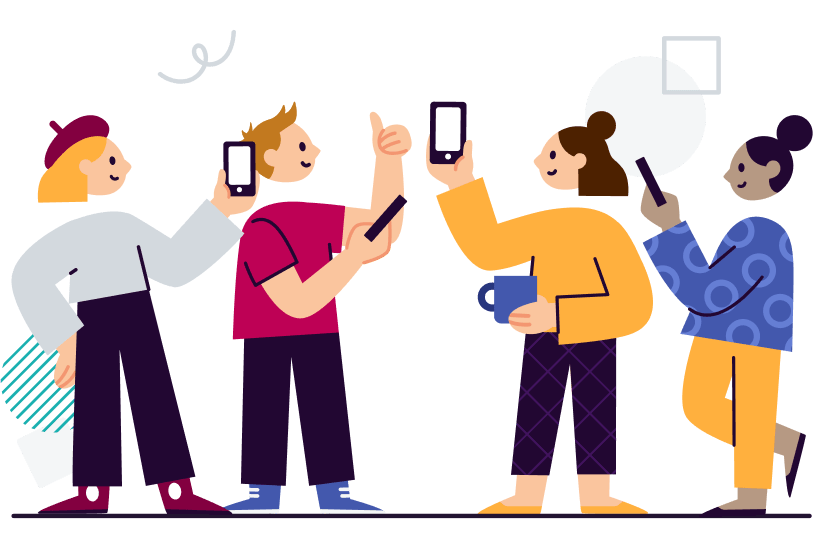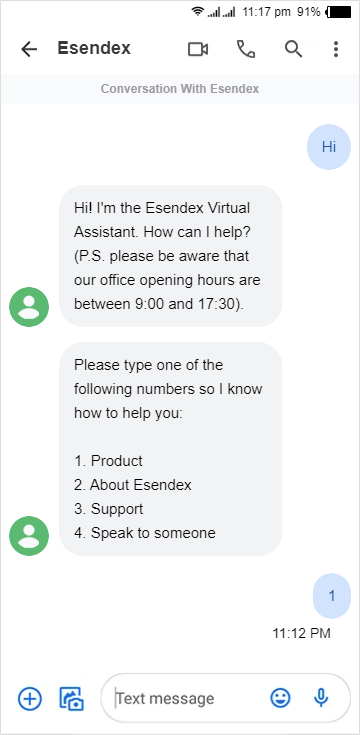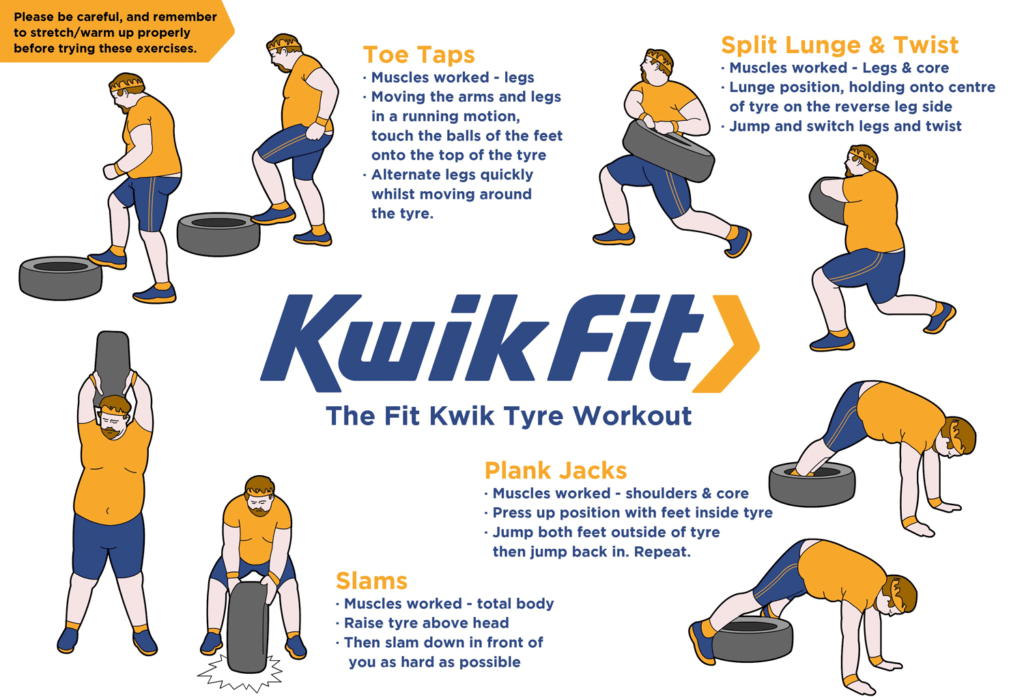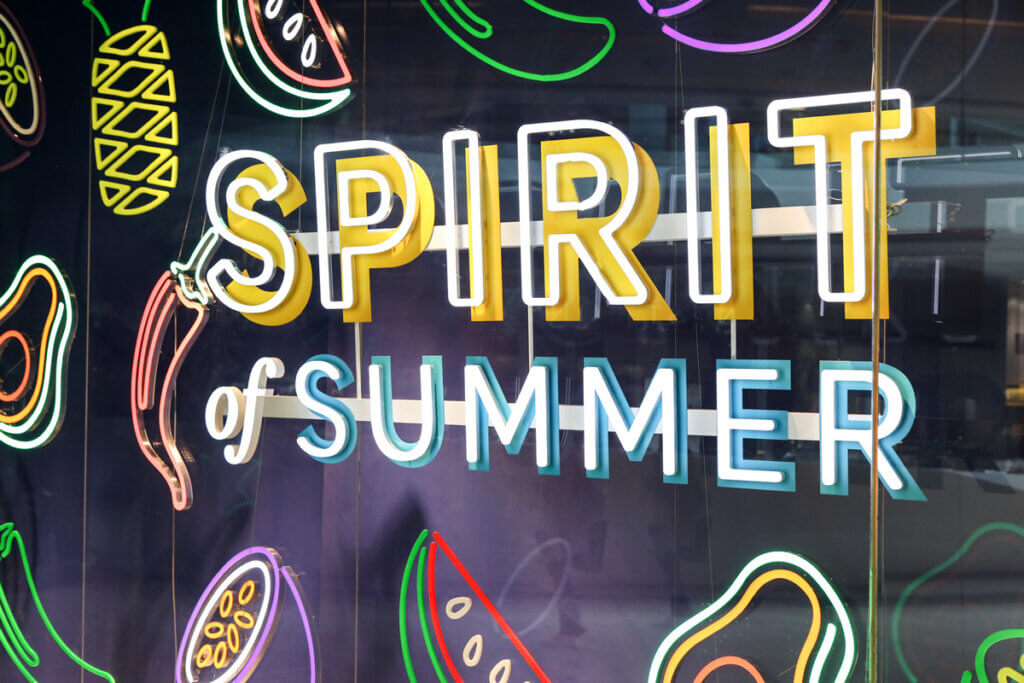EYEBROW HEADING
The business survival guide to peak season
The impact of peak trading periods on retailers and the commerce sector as a whole is clear. But how does peak season affect the businesses outside of retail and commerce? While crafting a watertight buyer experience won’t be a priority, they do still need to consider the quality of their customer service and experience. For example, communicating holiday opening hours well in advance and ensuring customers can easily find answers to their questions themselves (e.g. a chatbot, a knowledge base etc).
In our survival guide, we unpack our top tips and tricks to help you navigate peak season, ensuring you can still connect with customers and provide consistently excellent service. Scroll down to read the resource. And if you’d like your own copy to download and read on-the-go, grab the PDF version via the button below.

Contents
Not all of our topics may be relevant to you so please feel free to click on the headings below to skip to your desired section:
Peak season: A year-round phenomenon
The importance of an omnichannel customer experience
Tips to preparing for peak season
The key to order fulfillment success
The power of excellent customer service
What happens after peak season?
Best marketing campaigns to inspire your peak season strategy
Peak season: A year-round phenomenon
When we think of peak season, Black Friday, Cyber Monday, Boxing Day and New Year’s Day typically come to mind. Although summer is known for its sales too (e.g. Prime Day!), the heaviest markdowns and biggest spending usually happen later in the year. And it’s likely to stay this way, considering how enthusiastically the UK has embraced Black Friday.
Here are some statistics and consumer insights that might help you prepare for a day like Black Friday – or weekend, if you include Cyber Monday:
- Consumers like to rein in their spending in the lead-up to splurges – 76% of UK consumers stop shopping up to a month before Black Friday.
- Consumers do actually want to hear about Black Friday in advance – 83% are happy to hear about Black Friday sales up to four weeks in advance.
- WhatsApp is fast becoming a popular communication channel – 43% of consumers would opt-in to hear about seasonal sales via WhatsApp.
Despite the above being Black Friday statistics, they can still be applied to other peak trading periods.
Here are the main takeaways:
- Schedule your sale and promotion-related activities in advance.
- Adopt a multichannel communication strategy because not only will that broaden your reach but customers actually want to hear from you via WhatsApp, for example, in addition to email.
- Prioritise what you choose to send regularly – if you’re going to send SMS messages to customers weekly, they’ll most appreciate receiving key information e.g. delivery updates and payment reminders.
- Use mobile messaging channels to remind consumers of timely news e.g. SMS’s high delivery, open and read rates make it perfect for sending cart abandonment alerts and notifications that a promo code is expiring soon.
The importance of an omnichannel customer experience
Stand out from competitors by not only creating unique campaigns but also making the most of the marketing channels available to you. Allow customers and prospects to access your products, offers and services across a range of channels, devices and platforms. Let them choose the channel of their choice and travel along the journey that best suits them.
Here are some tips:
- Send follow-up reminders via other communication channels. For example, start with an email campaign and nurture via SMS or WhatsApp. In fact, this is a great way to re-engage with your inactive customers.
- Optimise your site for mobile – after all, 59% of global website traffic is generated via mobile devices.
- Upsell when you send order and dispatch confirmations. These are the notifications which are almost always read.
Read more about the power of an omnichannel strategy and how to create one here.
Tips to preparing for peak season
Get ready for the biggest sale periods of the year
Dates like Black Friday and Cyber Monday are among some of the most important dates for the commerce sector. It’s no wonder, considering global sales hit an all-time high of $9 billion in 2022 and there are no signs of this slowing down for 2023 and beyond.
So, how can you prepare for the biggest sale days of the year?

Start marketing early
If you’re wondering when is the best time to start Black Friday marketing, it’s typically 2-4 weeks before the big weekend. The same principle generally applies to other peak seasons, such as Christmas, New Year’s and summer sales.
Learn more about how to launch your marketing campaigns at the right time here.
Have a customer engagement strategy
Customer loyalty is hard won so if you want an engagement strategy that puts you in the winner’s circle, consider the following:
- Manage for change – as consumers work to navigate economic instability, their priorities may shift constantly. Ensure you can adapt your customer journey to align with this.
- Simplify for speed – consumers value speed and simplicity when it comes to engagement. Think along the lines of sale notifications or back in stock alerts.
- Personalise your messaging – use your CRM data to tailor every interaction to the individual customer.
- Analyse customer feedback – this will help you better understand what triggers customers to buy or bounce from your brand.
- Go multichannel – by offering a seamless brand experience across the channels your customers prefer, you make it easier for them to connect with you.
- Continuously engage – it’s not just about gaining new customers; make sure you also prioritise retaining them. Read more about how to re-engage with inactive customers in this article.


Directly reach customers with mobile messaging
Marketing channels such as email and even social media are becoming increasingly saturated. So if you’re looking for a way to directly reach and engage with customers, look no further than mobile messaging as it can help you to get ahead of the competition.
SMS, for example, has an average open rate of up to 98% and more than 90% of people read a text message within the first three minutes of receiving it. Here are some SMS marketing tips to help you get the most out of this channel:
- Tailor your message to the channel, industry and individual recipient.
- Choose the right call-to-action (CTA) – once you’ve won your customer’s attention, it’s time to have the right CTA that will entice them to continue their journey.
- Don’t underestimate the power of an omnichannel experience. Use SMS alongside your other marketing channels to maximise your reach.
- Create and maintain a consistent experience if you’re going to take the omnichannel approach.
Read about SMS marketing tips in more detail here.
Not in the commerce sector?
While we talk a lot about events like Black Friday, Christmas and summer sales, and how businesses can ensure their latest offers and products stand out from competitors, you can apply the above tips to industries outside of commerce.
Take holidays like Christmas and New Year’s, for example. There are likely to be changes to opening hours or potential delays in getting a response from customer service due to staff being on annual leave. Use a mobile messaging channel like SMS, RCS or WhatsApp to ensure your customers receive and engage with these updates.
Want to take advantage of the high engagement rates but not sure what to send? Or exactly how to phrase your messages? Check out our message template library, where you’ll find an array of RCS, WhatsApp and text message examples to copy and paste for your own campaigns.
The key to order fulfillment success
Your strategy for managing rapid surges in consumer demand
For those in commerce, ensuring the order fulfillment process is as efficient as possible is already a challenge. Add in the complexity of peak season and it becomes even more challenging to ensure your order fulfillment process won’t buckle under pressure.
During busy sales periods and the holiday season, your business can go from processing hundreds of orders a day to thousands overnight. What strategy have you got in place to manage these rapid surges in demand?
How to minimise order fulfillment issues
- If you have a webstore, ensure your website is ready for the increase in traffic as a seamless online experience can help minimise cart abandonment.
- Have complete visibility over inventory so you can prepare stock ahead of time and reduce customer frustration due to out of stock items, late or lost deliveries and more.
- Be equipped to track sales – this can help you improve ongoing and future promotions.
- Always keep customers informed in case things don’t go as planned. An up-to-date customer is often more forgiving than those who aren’t kept in the loop. This is where mobile messaging channels, with their high engagement rates, really have a chance to shine.
- Ensure cross-team collaboration as it may take more than one person within a team or multiple teams to solve a customer query.
Dive deeper into the logistical challenges of peak season and the secrets to order fulfillment success here.
The power of excellent customer service
How to provide it using mobile messaging
The quality of your customer service can make or break a customer’s experience with your brand. During busy periods, it’s even more important to provide excellent customer service.
Here are some ways you can do that and the role mobile messaging can play.

Respond quickly
The faster you can respond, the better. If you can’t (e.g. if your business is closed for the holidays or it’s taking you a bit longer than normal to get back to customers), set expectations by letting your customers know.
For example, if they’re opted in to receive SMS messages from you, send them a quick text that outlines when your team will be available. Not only is this a fast and easy way to inform customers of your holiday opening hours, but thanks to an open rate of up to 98%, it ensures your customers will most likely see the message.
If they happen to contact you outside of working hours, a simple automated message that informs them when you’ll be back can go a long way.
Example: Hey there! Thanks for your message, The [COMPANY] team has headed home for the holidays. We will be back on [DAY] at [TIME]. Please check our website for FAQs, support docs and more.
Ensure the experience is convenient
Make it easy for customers to reach you, whether that’s providing a variety of channels to contact you on (including the ability to self-serve) or proactively offering valuable information. For example, you can send follow-up content on product care or a video tutorial.
Offer support round-the-clock
In addition to offering customer-centric support, consider how you might be able to provide it 24/7. This is where self-service options come in handy. Rather than having a customer support team that’s available out of hours, why not make use of a chatbot?
Your bot can offer links to resources such as your blog, knowledge base or support documentation. And if that doesn’t help your customers, allow the chatbot to escalate the case to a live agent once your business reopens.
While the above tips can help you create a great retail experience, they can be applied to any industry that may be impacted by seasonal events.

50+ ready to use text templates
Discover the top SMS, WhatsApp and RCS message examples you should be sending.
What happens after peak season?
Defining your post peak season strategy
What your business does after peak season is as important as what you did before and during this period. If you’re in commerce, post-purchase dissonance and ‘buyer’s remorse’ can often be your next hurdle. This is why a post-purchase communications strategy is vital.
Think along the lines of:
- Detailed order and delivery confirmations
- Advice based on purchase history
- Tips to get more out of the purchase (e.g. tutorial videos, tips and tricks etc)
- Custom landing pages full of relevant content
Here are even more tips on how to reduce post-purchase dissonance.
If you’re not in the commerce sector, your post-peak season comms may consist of:
- Reminders of business opening hours
- Welcome back messages
- Seasonal greetings
Regardless of sector, your messages will not only help keep your business at the forefront of your customers’ minds, but also ensure that they don’t miss any important updates even after the busy period has passed.
Use mobile messaging to ensure your business is heard
Use a mixture of comms channels to maximise your reach. For example, your first port of call may be email. But how many other businesses will you be competing with to get your message seen? And that’s assuming your email won’t get lost in a spam folder.
This is where you can draw on the power of mobile messaging. Benefit from high open rates (up to 98% for SMS and 99% for WhatsApp) and conversion rates (up to 45%). A key challenge will be gaining opt-in – people are wary of giving their phone numbers away – which is why you shouldn’t stop using email to reach customers.
Improve mobile messaging opt in by:
- Offering special perks.
- Providing valuable content.
- Using your website.
- Using your social media channels.
Learn more about how to boost SMS marketing opt-in rate here and WhatsApp opt-ins here. Mobile messaging channels are very personal and allow you to send content directly into your customers’ hands. So, if you’re able to get their opt-in, they can help elevate your marketing efforts.
For those not in commerce, a combination of different channels can help ensure your messages are seen. Let’s say you needed to let customers know about your revised holiday opening hours. Or that your response times are a little longer than usual. Both of these are examples of information that your customers would appreciate knowing. Ensure that they don’t miss it by communicating it across various channels.
Best marketing campaigns to inspire your peak season strategy
Before we close up this resource and you head off to plan your next campaign, here are just a few of our favourite marketing campaigns of all time to inspire you.

Kwik Fit’s FitKwik campaign
“New year, new me!” – how often have we heard this saying? Car servicing and repair company Kwik Fit used this trend to market themselves in January. By offering a workout regime that involved a tyre and collaborating with a personal trainer, this is a great example of an immersive campaign.
M&S Food’s Spirit of Summer campaign
UK retailer Marks & Spencer took experiential marketing to the next level with their 2017 Spirit of Summer campaign. The pop-up event invited consumers to taste popular European dishes and drinks against a backdrop of live music. Talk about a marketing campaign to remember!


Lucy & Yak’s purchases with an impact
While most brands would focus on driving sales during Black Friday, independent UK clothing brand Lucy & Yak launched a six-day campaign that was centred on donating a portion of their profits to the Fior Di Loto school, next door to the brand’s first factory in India. This is a fantastic way to align your business with a charitable cause.
Sainsbury’s 2014 Christmas advert
Christmas is one of the busiest times of year, particularly in terms of marketing and advertising. A near-foolproof way to stand out? Tug on the heartstrings and invoke an emotional response in your audience – just as UK supermarket chain Sainsbury’s did for their 2014 campaign.

Here are some key takeaways from these campaigns:
- Invoke an emotional response from your consumers. For example, remind them of their childhood – nostalgia might be a great way to start!
- Analyse seasonal trends. Even if they might not be completely relevant to your sector, consider how you could make it so.
- Create a sensory experience for your consumers. If a pop-up event doesn’t quite suit, how about hampers or personalised merchandise?
- If you’d like to align your brand with a charitable cause, consider using peak trading season – such as Black Friday or summer sales – to promote it.
Inspired?
We have even more brilliant marketing campaigns and tips on how to take inspiration from them for your own campaigns. Dive deeper via the button below.
Make thriving during peak trading periods your reality
If there’s any time of the year that’s the busiest and most likely to be affected by reduced working hours, it’s the final quarter of the year, thanks to dates like Christmas, the New Year, Black Friday (which the UK has embraced) and Cyber Monday. But there’s the summer, where commerce also typically booms (“summer sales!”) and people flock off on their holidays, leaving business places slightly quieter than before.
In short, ‘peak season’ is a year-long affair, which means your customers are always on the lookout for great deals, ready to purchase goods and services, while simultaneously expecting excellent service.
Want to find out more?
Our survival guide covers some of the things businesses can do to ensure they’re still able to connect with customers and provide consistently great service. But that’s just the beginning. If you’d like to learn more about how to go beyond surviving and instead, thrive during these peak periods, reach out to us today.

